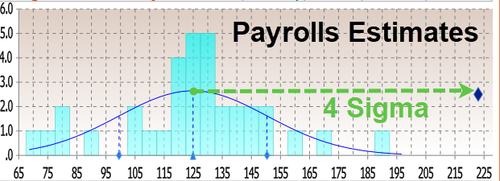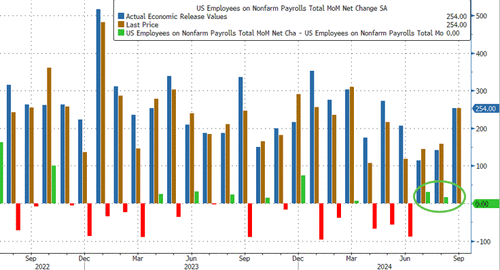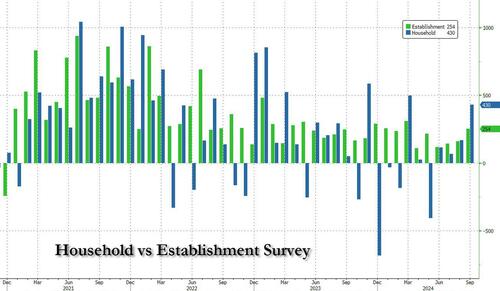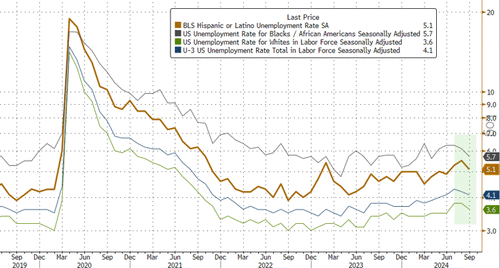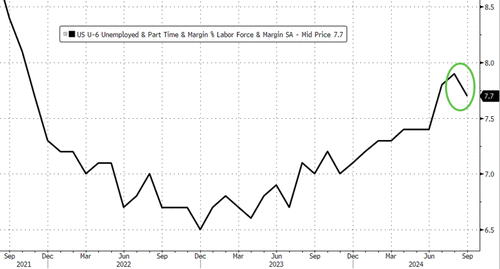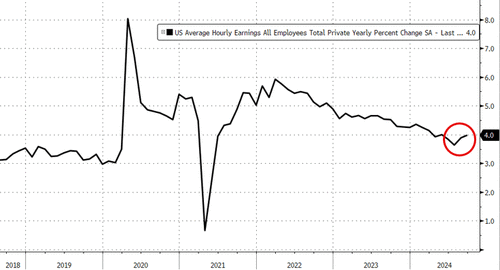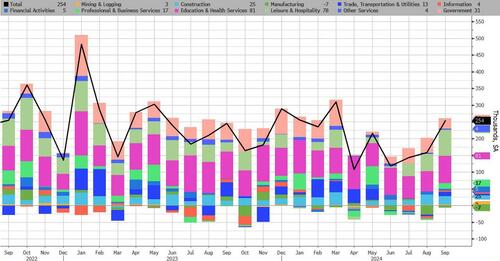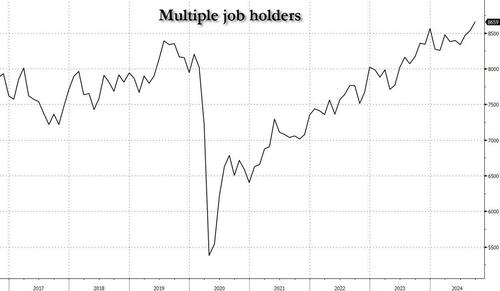Blowout Payrolls: Sept 254K Jobs Soar Above Highest Estimate, Unemployment Rate Drops And Wages Spike
It turns out that Powell's "emergency" 50bps rate cut was - drumroll - another major policy mistake by the Fed.
Moments ago, the BLS reported that at a time when prevailing consensus was for jobs to continue their recent downward slide sparked by the near-record annual jobs revision and several months of downbeat jobs reports, in September the US unexpectedly added a whopping 254K jobs, the biggest monthly increase since March, higher than the average monthly gain of 203,000 over the prior 12 months. ...
... and above the highest estimate (which as noted last night was from Jefferies at 220K). In fact, the number was a 4-sigma beat to the median estimate!
There's more: unlike previous months where we saw repeat downward job revisions, the BLS said that both prior months were revised up, to wit: the change in total nonfarm payroll employment for July was revised up by 55,000, from +89,000 to +144,000, and the change for August was revised up by 17,000, from +142,000 to +159,000. With these revisions, employment in July and August combined is 72,000 higher than previously reported.
Some context: as UBS notes, the moving six-month average on nonfarm payrolls is 167k. The estimate is that 150k is about consistent with a return of the economy to trend growth. Which means that inflation is about to come back with a vengeance, just as the Fed launches its easing cycle.
Remarkably, while payrolls jumped by the most in half a year, the number of employed people also surged, rising by a whopping 430K, also the biggest one-month jump since March.
d
It wasn't just the payrolls, however, which came in far stronger than estimates: the unemployment rate also came in stronger than expected, and thanks to the jump in employed workers coupled with the decline in unemployed workers (from 7.115MM to 6.834MM), it dropped from 4.2% to 4.1% (and down from 4.3% two months ago which spared the entire recession panic).
Among the major worker groups, the unemployment rate for adult men (3.7 percent) decreased in September. The jobless rates for adult women (3.6 percent), teenagers (14.3 percent), Whites (3.6 percent), Blacks (5.7 percent), Asians (4.1 percent), and Hispanics (5.1 percent) showed little or no change over the month.
The underemploeyment rate, while not as closely watched, also made a big move dropping from 7.9% to 7.7%.
Meanwhile, the labor force participation rate was 62.7% for the third consecutive month, and the employment-population ratio was little changed at 60.2%.
Some more statistics from the report:
- The number of people employed part time for economic reasons changed little at 4.6 million in September. This measure is up from 4.1 million a year earlier. These individuals would have preferred full-time employment but were working part time because their hours had been reduced or they were unable to find full-time jobs.
- The number of people not in the labor force who currently want a job, at 5.7 million, changed little in September. These individuals were not counted as unemployed because they were not actively looking for work during the 4 weeks preceding the survey or were unavailable to take a job.
- Among those not in the labor force who wanted a job, the number of people marginally attached to the labor force increased by 204,000 to 1.6 million in September. These individuals wanted and were available for work and had looked for a job sometime in the prior 12 months but had not looked for work in the 4 weeks preceding the survey. The number of discouraged workers, a subset of the marginally attached who believed that no jobs were available for them, changed little at 445,000 in September.
And here is the rub, because in a vacuum the super strong jobs numbers would have been fantastic, the only issue is that the September blowout comes as the Fed launches an easing cycle and as wages are once again rising as we have warned for the past 3 months. Indeed, in September, the average hourly earnings rose 0.4% sequentially, beating the estimate of 0.3%, while on an annual basis, wage growth was 4.0%, up from an upward revised 3.9% and beating the 3.8% estimate.
One note here: the average workweek for all employees edged down by 0.1 hour to 34.2 hours in September, which means the hourly earnings increase is not "pure" but rather a function of denominator adjustments. In manufacturing, the average workweek was unchanged at 40.0 hours, and overtime edged down by 0.1 hour to 2.9 hours. The average workweek for production and nonsupervisory employees on private nonfarm payrolls remained at 33.7 hours.
Taking a closer look at the composition we find that employment continued to trend up in food services and drinking places, health care, government, social assistance, and construction. Here are the details:
- Employment in food services and drinking places rose by 69,000 in September, well above the average monthly gain of 14,000 over the prior 12 months.
- Health care added 45,000 jobs in September, below the average monthly gain of 57,000 over the prior 12 months. Over the month, employment rose in home health care services (+13,000), hospitals (+12,000), and nursing and residential care facilities (+9,000).
- Employment in government continued its upward trend in September (+31,000). Government had an average monthly gain of 45,000 jobs over the prior 12 months. Over the month, employment continued to trend up in local government (+16,000) and state government (+13,000).
- Employment in social assistance increased by 27,000 in September, primarily in individual and family services (+21,000). Over the prior 12 months, social assistance had added an average of 21,000 jobs per month.
- Construction employment continued to trend up in September (+25,000), similar to the average monthly gain over the prior 12 months (+19,000). Over the month, nonresidential specialty trade contractors added 17,000 jobs.
- Employment showed little change over the month in other major industries, including mining, quarrying, and oil and gas extraction; manufacturing; wholesale trade; retail trade; transportation and warehousing; information
And visually:
What is also notable is that whereas in previous months the BLS would rig the headline print by boosting either foreign-born workers, or part-timers, this time that did not happen, as the number of native born workers rose (from 129.712MM to 130.632MM) offset by a drop in foreign-born workers (from 31.636MM to 31.414MM)...
... while the number of full-time workers rose offset by a drop in part-timers.
In fact, the only ugly qualitative aspect of the job report was the surge in multiple jobholders which hit a new record high.
Commenting on the data, James Knightley at ING said the data was unambiguously strong, but there are headwinds:“Our base case remains that the US can achieve a soft landing on the assumption that a fundamentally sound economy responds to rate cuts and greater political clarity after the election. Nonetheless we feel that the risks remain skewed towards weaker growth and lower Fed funds given the perception amongst households of a deteriorating jobs market (even if today’s numbers don’t confirm that) may lead to consumers spending more cautiously.”
Others however were quick to point out the politically motivated emergency jumbo cut by the Fed, which in retrospect was unnecessary: here is Seema Shah of Principal Asset Management, who says the Fed is going to have to swing its gaze back to inflation.
“Did the Fed even need to cut rates in September, let alone cut by 50bps? The monster upside surprise suggests that the labor market may actually be a picture of strength, not weakness, and it completely dismisses the idea that the Fed could even contemplate another 50bps cut in November. As jobless claims, the Challenger survey, and the multitude of strong economic data have been suggesting, the U.S economy is still robust. And with Fed easing now underway, recession risk has collapsed. Markets will need to keep a closer eye on inflation as, now, there are policy risks on both sides of the economy.”
Which brings up a comment from Bloomberg Fed watcher Chris Anstey who writes that one scenario not many have discussed is this: If the unemployment rate doesn’t go up, and if inflation keeps coming down, is there a case for the Fed to simply call off the rate-cut cycle at some early point? That would really revive the argument about the mid-1990s parallel, when the Fed lowered rates a couple of times in late 1995 and early 1996 and then ceased and desisted.
Expect a lot of Fed chatter on this point in the coming days, although probably not before the elections... for obvious reasons.



